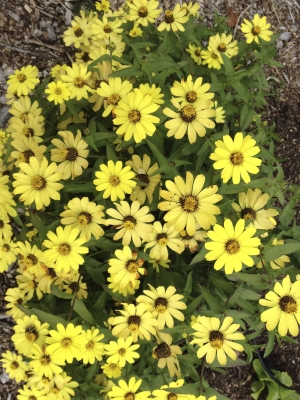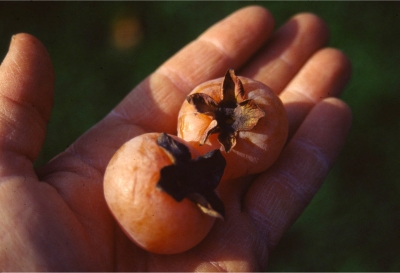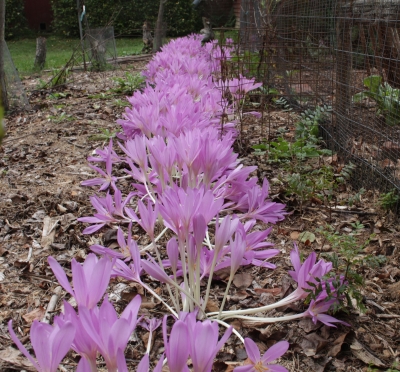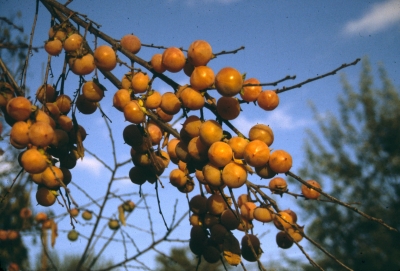COMPOST, FERTILITY, & SUSTAINABILITY
/13 Comments/in Gardening, Soil, Vegetables/by Lee ReichCompost and/or Living or Dead Organic Material = Sustainable Fertility
Maple leaves already dapple the ground in red and yellow (early this year), one morning showed off what was to come with frost on the windshield, and each day the sun each hangs lower in the sky, yet I’m getting ready for spring planting. Really! Yes, I’d rather do it now than in spring.
Beds of spent vegetables have been cleared. Okra plants, in this cool weather, just sat in place, hardly producing any new pods. So out went the plants. I severed the main roots with my hori-hori knife (www.oescoinc.com) and yanked out each stem. When corn is finished, it’s finished. Beds of early corn got replanted with endive, lettuce, and other late vegetables, but the latest beds of corn were harvested too late for replanting. Clearing away old vegetable plants not only clears the deck for next spring but also takes offsite some pests and diseases that might otherwise lurk around next year to do their evil work.
With spent vegetable plants cleared away — tomatoes and peppers are still yielding fruits, so they remain for now — I remove weeds. Ideally, all of them. Left in place, annual weeds spread seeds and roots of perennial weeds grab more tenaciously and deeper into the soil. A single pigweed plant, for instance, can drop 120,000 seeds, poised and ready to invade next year’s garden. That, and the 36,000 seeds on every plantain plant, the 39,000 seeds of each lamb’s-quarter plant, and the 8,000 seeds clustered in a crabgrass seedhead prompts me to pull these weeds now, before more seeds mature.
Of course, some weeds escape my notice, so the final step in preparation for spring is to suffocate these: I slather each planting bed with a one inch depth of mostly weed-free compost. A temporary 2X4 at each edge of the bed keeps the compost neatly in place until patted down firmly.
The compost does more than snuff out overlooked weeds. Its biotic life helps protect plants against pests and diseases. It helps soils hold water and air. And it feeds plants a smorgasbord of nutrients.
On a Garden, Farmden, or Small Farm, Fertility Simplified
Did I mention spreading fertilizer, “organic” or otherwise, in getting the soil ready for spring planting? No. A one-inch depth of compost supplies all the nutrients needed to grow vegetables, even in beds with closely spaced plants. Paraphrasing the Beatles lyrics, “All you need is . . .compost, da, da, da-da da.”
A garden is not Mother Nature left to her own devices; nonetheless, I try to emulate her as much as is practical. She does not spread fertilizer. Plants are naturally nourished as organic materials, such as leaves, stems, wood, roots, and dead animals, decompose to release whatever nutrients gave them life. I enjoy making compost and make enough to spread that required one-inch depth over all the beds.
Next best would be to spread some concentrated source of the most needed nutrients, that is, “fertilizer,” on the ground and supplement it with a mulch such as wood chips, straw, hay, or other organic material. Here, an organic fertilizer, such as soybean or alfalfa meal, has the advantage over a chemical fertilizer in that nutrients become available over a long time and are made so in response to temperature and moisture, in synch with plants’ needs.
Two advantages of maintaining fertility with compost rather than mulch plus fertilizer are that seeds are more easily planted directly in the compost and compost, if made from a variety of feedstuffs, provides a wider spectrum of nutrient for the plants.
Cover Crops, Used Correctly, for Even Large Farms
A wheat farmer in Montana is not going to be spreading an inch of compost on his 1,000 acres, or even soybean meal and a mulch of straw. Agriculture is a balancing act, again, not Mother Nature but not disrespecting her either. In the case of a wheat farmer, or any large scale farm, cover crops are a practical route to healthy soil.
Cover crops are plants grown specifically to maintain or improve a soil. Cover crops may occupy the ground for part or for the whole season. As they grow, their roots push through the soil to break it up and, upon their death, leave channels for air and water. Roots exude natural compounds that stimulate a a wide population of beneficial microbes and release nutrients from the soil’s rocky matrix. Leguminous cover crops garner nitrogen from the air into a form that plants can gobble up. And once dead, deliberately or with age, cover crops can maintain or increase all important soil organic matter.
The devil is in the details. Killed too young, while still lush and green, a cover crop adds nothing in the way of soil organic matter (but does protect the soil surface from erosion). Tilling a cover crop into the soil, a common practice, might burn up more organic matter, by giving the ground a big burst of oxygen, than is added by the cover crop, whether the cover crop is young or old. And then there is the choice of cover crop itself for regional adaptability, for shading out weeds, or for beefing up a poor soil.
How about this? Set aside a separate area for cover cropping each year. Or set aside a separate area for cover cropping, but mow the plants one or more times through the growing season to provide mulch or feedstuff for compost. With enough land and suitable mix of cover crops, including legumes for nitrogen.
—————————————-
“Sustainability” is a buzzword these days. Nourishing the ground with nothing more than annual sprinklings of chemical fertilizer not sustainable in terms of long-term soil health and because synthetic fertilizers require fossil fuels in their making. At he other end of the scale, primitive slash and burn agriculture, where land is cleared and burned, crops planted for a few years, then the site abandoned for a new site, is sustainable. But you need enough land to be able to leave time for the soil to naturally regenerate before another slashing and burning. In our “advanced” culture, recycling organic materials back to the land is also sustainable. It’s just a matter of getting the materials back into the soil, as compost or more directly, but not to a landfill or an ethanol (gasahol) factory.
FLOWERS FOR THE VEGGIE GARDEN
/11 Comments/in Design, Flowers, Gardening/by Lee ReichZinnias In and Colchicum Outside
And the winner is . . . Every year boxes of plants arrive at my doorstep, sent by nurseries and seed companies hoping to wow me with their products which I will then praise and induce you all to purchase. Most of the plants turn out to be ho-hum, perhaps new but not necessarily better than what’s been around for decades. Not so this season, for a charming yellow flower that’s been blooming nonstop all summer long and offers no indication as yet of expiring.
That plant is . . . unfortunately I lost the label so have been sleuthing for days now to give this winning plant a name. It looks much like a zinnia, a single flowered zinnia, that is, one with a single row of petals. The plants are compact, a little more that a foot high and wide, and — very un-zinnia-like — show no signs of powdery mildew.
My first guess for the plant was creeping zinnia, which actually can be one of two different plants. The first is a true zinnia, Zinnia angustifolia, and the second is not really a zinnia; it’s Sanvitalia procumbens. After getting out my botany books (books!) and magnifying glass and staring at the peduncle, receptacle, and disk and ray flowers of a flower from my plant and comparing it with written descriptions, I was still scratching my head to give my plant a name.
In frustration, I went to the garage to my “miscellaneous” bucket into which I sometimes toss plant labels that I might need to reference again at a later date. Digging down deep amongst all shapes and sizes of labels, I came upon one printed “Zahara Yellow Improved Zinnia.” Back inside, on the web, comparing descriptions and photos verified that — yes — that’s the plant.
The botanical name listed for Zahara zinnias, which also come in other colors, is Zinnia Marylandica. That species name looks and is fake. Zaharas are interspecies hybrids, with some creeping zinnia (the Z. angustifolia c.z.) in their blood. So my guess at their being creeping zinnia was not far off.
Looking over at my conventional zinnias (Zinnia elegans) for comparison, they appear gawky witI their large flowers, both new and faded ones, prominently perched atop long stalks. Their many petalled blossoms look too full of themselves. Zahara buries its spent blossoms out of sight amongst new flowers and foliage of the compact plants.
Next year, I’m planting Zahara Yellow Improved Zinnias again.
A Vegetable Factory Functionally, But Not Visually
Those Zahara zinnias, planted along the main path of the vegetable garden joining arbored gates at either end, create two golden ribbons to draw you along the path. As I walk the path and glance left, north, I see, just outside the garden fence, another ribbon, this one a broad brush stroke of purple with not a hint of green. (More on that later.)
A vegetable garden need not be a vegetable factory. Too many look as if dropped from the sky, plopped down in the middle or far corner of lawn and enclosed with a strictly functional fence. Why not make the vegetable garden pretty and cozy it up near the house? Beds paint a two-dimensional design on the ground. A nice fence helps; even better if it integrates with the style of the home.
Vegetable gardens often look stark because of the abrupt transition between the vertical fence and adjacent, horizontal lawn. Decades ago, I regularly rototilled around the outside of my fence to keep weeds away from the fence line. I decided that was wasted space, so planted it with shrubs, flowers, and vegetables that didn’t need fencing. It was a good decision, softening the transition from garden to lawn.
So gussy up your vegetable garden with ornamental plants inside and out, with decorative fencing and arbors, perhaps an herb-lined path drawing you within, or perhaps with a bench, bird bath, or gazing globe as a draw.
And A Stripe of Purple to Gussy Up the North
That purple brush stroke north of my vegetable garden are the petals of autumn crocus, Colchicum autumnale. In contrast to the Zahara zinnias, autumn crocus has been cultivated hundreds of years, and my plants are run-of-the-mill species rather than any hifalutin variety.
Like Zahara zinnias, autumn crocus has nomenclature issues. To whit, it is not a crocus. Further complicating things, there are true crocuses that bloom in autumn, sometimes called autumn-blooming crocuses, among them the saffron crocus, Crocus sativa. Colchicum autumn crocus, my purple brush-stroke, is poisonous.
The purple of my autumn crocuses is so bold because leaves don’t accompany the flowers (again, in contrast to autumn-flowering crocuses, whose leaves appear with the flowers). Autumn crocus leaves are big and bold, appearing in spring and looking something like ramps, the edible wild onion species. In Europe, where both autumn crocus and a ramp-like relative, grow, people have been poisoned for mistaking one plant for the other.
But toxicity isn’t what keeps more people from planting autumn crocus. Daffodils, after all, also are toxic. The problem is timing: Autumn crocus bulbs are ready for planting in late summer, before daffodils, tulips, and other fall planted bulbs are ready. It’s hard for nurseries to get people excited about yet another bulb planting season, and only for this single species. If not planted soon enough, autumn crocus bulbs grow, even without soil. The bulbs multiply quickly and when I divided and replanted them last summer, I kept a few out, three of which now sit naked in a bowl on the dining table, blooming.
Fruit, Grain, & Vegetable
/13 Comments/in Fruit, Gardening, Pruning, Vegetables/by Lee ReichHomegrown Persimmons, Popcorn, and Brussels Sprouts, All in Abundance
It’s raining persimmons! And every morning I go out to gather drops from beneath the trees. And every afternoon. And, depending on the wind and the temperature, sometimes early evenings also.
The fruits are delicate, their soft jelly-flesh ready to burst through their thin, translucent skins. Most fruits survive the trip from branch to ground unscathed because of the close shorn, soft, thick lawn landing pad that awaits them. I pop any that burst right into my mouth or else toss them beyond the temporary, fenced-in area as a treat to my the ducks or to Sammy, my dog who has developed a taste for the fruit. (The ducks, Indian Runners, hardly fly but Sammy, if he put two and two together, could easily hop the low fence and beat me to the fruits.) Repeatedly gathering fruit through the day is needed to keep ahead of scavenging insects.
American persimmons grow wild throughout much of the eastern part of our country, about as far north as the Hudson Valley. Wild trees bear either female or male flowers. Males, which never bear fruit, can each sire a few females, which are the ones that do bear fruit. Puckery flavor is the main problem with wild persimmons. They can make your mouth feel like a vacuum cleaner is at work within. All American persimmons elicit that unpleasant feeling until fully soft, colored, and ripe; some elicit the feeling, in some measure, even when ripe.
Planting a named variety can spell the difference between a fruit to spit out and a fruit to swoon over. Said variety needs to be one that, besides tasting good, ripens within the growing season, and isn’t harvested until dead ripe. (Many otherwise good varieties do not have time to ripen this far north.) Szukis and Mohler do particularly well here near the northern limit for persimmon growing, Mohler beginning its ripening at the end of August, and Szukis the end of September. Both varieties ripen fruits over a long period, for a month or more.
One more asset for Mohler, Szukis, and some other varieties is that they make males superfluous. They can set fruit parthenocarpically (without pollination) and/or by pollination from their own occasional male blossoms. Most Mohler and Szukis fruits are seedless, a sign of parthenocarpy, but occasional fruits have a seed or two, indicating that some pollination took place.
Once leaves drop from these trees, fruiting is not finished. Ripe, orange fruits will cling for weeks to bare branches like Christmas ornaments, although, with time, fruits shrivel and brown, losing their visual — but not gustatory — appeal. Not bad for a tree that needs nothing in the way of pruning or pest control, eh?
Popcorn’s Not Just for the Movies
With the fruit course out of the way, let’s move on to the grain course. I’ve tried growing wheat and rice on a (very small) garden scale, and yields were paltry and sometimes difficult to get at because of topheavy plants flopping to the ground. Flopping was probably due to too much fertility and moisture. Processing either grain was a project in itself, entailing removal of the grain from the stalks and then from their husks.
The easiest grain to grow and process on a backyard scale is popcorn, which revels in my soil’s good fertility and moisture. I grow popcorn the same way as sweet corn, in “hills” (which, horticulturally speaking, are stations or clusters rather than raised mounds) with 3 to 4 plants per hill and two rows of hills in each 3 foot wide bed, with two feet from hill to hill within each row.
The only downside to growing popcorn on a small scale is the need to keep it away from sweet corn, if you grow that also. Planting sweet corn and popcorn too close to each other lets them cross-pollinate, resulting in sweet corn that is less sweet and popcorn kernels than wanly split to exhale steam rather than blow apart till they’re inside out.
Even with popcorn grown in sufficient isolation, correct moisture level (20 percent) is what makes for good popping. I wait to harvest until the ears and husks are dry on the stalks. After harvest, I peel back the husk, leaving a few layers, pull off the browned silk, then tie 3 or 4 ears together by their pulled back husks and hang the bunch from the kitchen rafters to dry.
The ears hang from the rafters all year ready for popping. When I feel like eating some popcorn, I just twist the kernels off a cob; microwavers can put the cob, intact, into their microwave ovens. I find that poppability varies through the year, probably depending on the temperature and the humidity.
If I sought maximum poppability, I could measure the moisture level by accurately weighing out a portion of kernels and drying them in a 150°F. oven overnight, then re-weighing them. But how big the kernels can puff up isn’t nearly as important to me as the fact that popcorn is an easy-to-grow, nutritious, whole grain that’s tasty and fun to eat.
The Sprouts Responded to Being Pinched
Finally, moving on to the vegetable course. A few weeks ago I wrote about sizing up the sprouts of Brussels sprouts by pinching the tips of the plants. That stops the production of the hormone auxin, which had been suppressing sprout growth further down along the stem.
The suppression is only temporary. As uppermost buds start to grow, they, in turn, start pumping down auxin. Those 3 or 4 upper buds now threaten to expand to become stems. At this point they can do what they will because lower buds — the sprouts — have all puffed up to good size.








